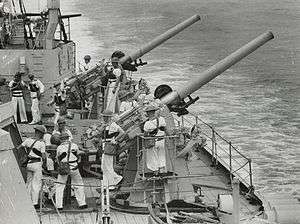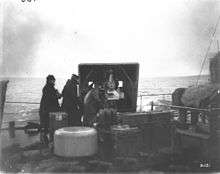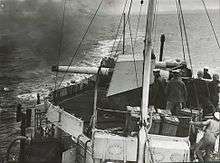QF 4-inch naval gun Mk V
The QF 4 inch Mk V gun[note 1] was a Royal Navy gun of World War I which was adapted on HA (i.e. high-angle) mountings to the heavy anti-aircraft role both at sea and on land, and was also used as a coast defence gun.
| Ordnance QF 4 inch gun Mk V | |
|---|---|
 QF 4 inch HA guns aboard the cruiser HMAS Sydney, 1939–1940 | |
| Type | Naval gun Anti-aircraft gun Coastal defence gun |
| Place of origin | United Kingdom |
| Service history | |
| In service | 1914 - 1945 |
| Used by | British Empire |
| Wars | World War I World War II |
| Production history | |
| No. built | 944[1] |
| Specifications | |
| Mass | Barrel & breech: 4,890 lb (2,220 kg)[2] |
| Barrel length | Bore: 15 ft (4.6 m) (45 cal) Total: 15 ft 8 in (4.8 m)[2] |
| Shell | 31 lb (14.1 kg) fixed QF or Separate-loading QF |
| Calibre | 4-inch (101.6 mm) |
| Breech | horizontal sliding-block |
| Recoil | hydro-pneumatic or hydro-spring 15 inches (380 mm) |
| Elevation | mounting dependent |
| Traverse | mounting dependent |
| Muzzle velocity | 2,350 ft/s (716 m/s)[2] |
| Maximum firing range | Surface: 16,300 yd (15,000 m)[3] AA: 28,750 ft (8,800 m)[2] |
| Filling | Lyddite, Amatol |
| Filling weight | 5 pounds (2.27 kg) |
Service
Naval service


This QF gun was introduced to provide a higher rate of fire than the BL 4 inch Mk VII. It first appeared in 1914 as secondary armament on Arethusa-class cruisers, was soon adapted to a high-angle anti-aircraft role. It was typically used on cruisers and heavier ships, although V and W-class destroyers of 1917 also mounted the gun.
Mk V was superseded by the QF 4 inch Mk XVI as the HA (i.e. anti-aircraft) gun on new warships in the 1930s, but it continued to serve on many ships such as destroyers, light and heavy cruisers in World War II.[4]
Army anti-aircraft gun
Early in World War I several guns were supplied by the Navy for evaluation as anti-aircraft guns for the home defence of key installations in Britain. They were mounted on static platforms and proved fairly successful after a fixed round was developed to replace the original separate round, and more followed. The AA mounting allowed elevation to 80° but loading was not possible above 62°, which slowed the maximum rate of fire.[5] At the Armistice a total of 24 guns were employed in AA defences in Britain and 2 in France.[6] After World War I the guns were returned to the Navy.
Coast Defence gun
From 1915 to 1928 several guns were mounted in forts to guard the estuary of the River Humber.[7]
Anti-aircraft performance
The following table[8] compares the gun's performance with the other British World War I anti-aircraft guns:-
| Gun | m/v ft/s | Shell (lb) | Time to 5,000 ft (1,500 m) at 25° (seconds) | Time to 10,000 ft (3,000 m) at 40° (seconds) | Time to 15,000 ft (4,600 m) at 55° (seconds) | Max. height (ft)[9] |
| QF 13 pdr 9 cwt | 1990 | 12.5 | 10.1 | 15.5 | 22.1 | 19,000 |
| QF 12 pdr 12 cwt | 2200 | 12.5 | 9.1 | 14.1 | 19.1 | 20,000 |
| QF 3 inch 20 cwt 1914 | 2500 | 12.5 | 8.3 | 12.6 | 16.3 | 23,500 |
| QF 3 inch 20 cwt 1916 | 2000 | 16 | 9.2 | 13.7 | 18.8 | 22,000[10] |
| QF 4 inch Mk V World War I | 2350 | 31 (3 c.r.h.) | 4.4?? | 9.6 | 12.3 | 28,750 |
| QF 4 inch Mk V World War II [11] | 2350 | 31 (4.38/6 c.r.h.) | ? | ? | ? | 31,000 |
Ammunition
Ammunition for the original low-angle guns introduced in World War I was Separate QF i.e. the shell and cartridge were separate items, but in World War II most guns used Fixed QF ammunition i.e. a single unit. The fixed Mk V ammunition was 44.3 inches (1.13 m) long and weighed 56 pounds (25 kg), while the projectile was 31 pounds (14 kg).[12]

Fixed QF cartridge for LA (low-angle) gun, 1930s 
Crew storing fixed rounds on the Kingfisher class sloop HMS Widgeon, August 1943
See also
Weapons of comparable role, performance and era
- Cannon 102/45 Italian copy of the QF Mk V made under license
- 10.5 cm SK L/45 naval gun Approximate German equivalent firing slightly heavier shell
Surviving examples
- A gun from HMNZS Tutira in front of the Devonport Naval Base, Auckland, New Zealand
Notes
- Mk V = Mark 5. Britain used Roman numerals to denote Marks (models) of ordnance until after World War II. Mark V indicates this was the fifth model of QF 4-inch gun.
References
- Tony DiGiulian quotes 283 Mk VC built for the navy during WWII; 554 earlier types built for the navy; about 107 earlier types built for the Army in WWI.
- Hogg & Thurston 1972, Page 101
- WWI 3 c.r.h. HE shell. Tony DiGiulian, "British 4"/45 (10.2 cm) QF Mark V and Mark XV"
- Tony DiGiulian's webpage provides comprehensive information on this gun's Naval service. Tony DiGiulian (January 13, 2008). "British 4"/45 (10.2 cm) QF Mark V and Mark XV". Retrieved 2008-03-29.
- Hogg & Thurston 1972, Page 100
- Routledge 1994, Page 27
- Hogg & Thurston 1972, Page 98
- Routledge 1994, Page 9
- Hogg & Thurston 1972, Page 234-235
- Routledge 1994, Page 13
- WWII details from Tony DiGiulian's website
- Campbell, Naval Weapons of WWII, p.58.
Bibliography
- Tony DiGiulian, British 4"/45 (10.2 cm) QF Mark V and Mark XV
- I.V. Hogg & L.F. Thurston, British Artillery Weapons & Ammunition 1914–1918. London: Ian Allan, 1972.
- Brigadier N.W. Routledge, History of the Royal Regiment of Artillery. Anti-Aircraft Artillery, 1914–55. London: Brassey's, 1994. ISBN 1-85753-099-3
- Campbell, John (1985). Naval Weapons of World War Two. Naval Institute Press. ISBN 978-0-87021-459-2.
External links
| Wikimedia Commons has media related to QF 4 inch Mk V naval gun. |
- Gun drill for 4-inch Q.F. gun mark V (land Service) 1924 at State Library of Victoria